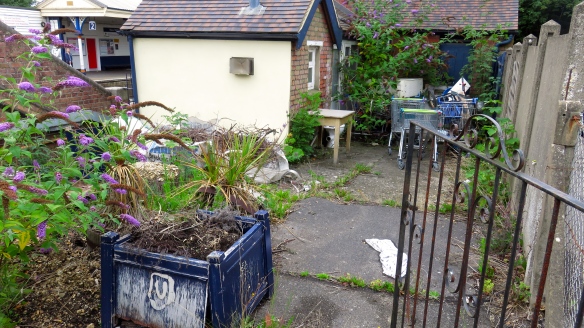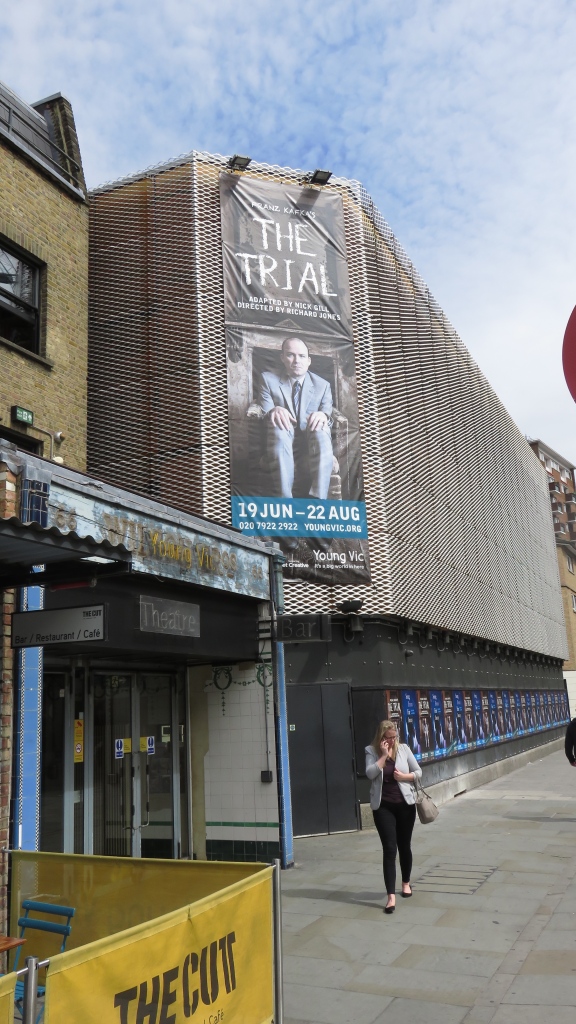Jackie drove me to and from New Milton station today, in order for me to travel to Waterloo to lunch with Carol.
The Hampshire station itself is impeccably kept, but the garden attached to the railway buildings has seen better days. It now boasts a collection of discarded supermarket trolleys, burst wooden planters, and the ubiquitous buddleia plants.
On the journey up, I enjoyed a brief spell as an interfering old git. I walked through two of the five carriages before I found a seat. I had to claim it. I came to a halt between two four seat sections. Only four of the eight held passengers. On one side a young couple sat opposite their wheeled case laid across the other two. Alongside them one seat was occupied by a walking stick; another by a backpack. I announced: ‘Well, I need one of these’. A young man politely settled his bag on his knees.
Throughout the journey people stopped, looked at the large case, and silently walked on. Soon, an announcement informed us that more customers were expected, and asked that luggage be removed from seats. The couple did not move. After a minute or two, ‘excuse me’ said I, and asked the man if he had heard the announcement. ‘I did’, he replied. ‘And you have seen people looking at your case and moving on?’, I continued. There was no reply. In mitigation I said that I knew this was a difficult train for luggage. ‘I’ll find somewhere to put it’, he said, and carried it back down the carriage. After he had done so, another man, who had twice walked on past the case, and must have been standing in the aisle further along, collapsed into one of the now vacant seats and thanked the young man. A woman sat in the other, and also expressed gratitude.
From Waterloo I walked along The Cut to Tas restaurant.
In Cornwall Road, SE1, a young woman sat on a low wall, speaking into her mobile phone, in  This plot is very small, and contains no benches, but at least they have made an effort.
This plot is very small, and contains no benches, but at least they have made an effort.
‘High Society’ is still being performed at The Old Vic, and further along The Cut, Rory Kinnear looks down on us from The Young Vic where he is receiving acclaim for his performance in ‘The Trial’.
Smoking is not, of course, permitted in our theatres, or in any other workplace or public building. Perhaps that is why the sunken gravel-coated paving around a nearby young plane tree has been converted into an ashtray.
Even before I passed these famous theatres, I was thinking of the Robin Hood Theatre at Averham, just outside Newark in Nottinghamshire. It was the setting of Rumer Godden’s novel ‘A Candle for St Jude’, that brought it to mind. This book was my train reading. Except to say that the action takes place in a private theatre, I will write more about it when I have finished it.
 Robin Hood Theatre’s website describes it as ‘a timber-built private theatre of 1913 set in the grounds of the former Rectory; outbuildings which were once stables are now used for storing scenery, properties and costumes. One such outhouse contains two small dormitories which can accommodate drama students on their occasional visits to the theatre. The auditorium is on one level, the rear half raked, seated in 15 straight rows each containing ten seats. This is a most interesting and much-loved little playhouse. The backstage arrangements are quaint, compact and different.’
Robin Hood Theatre’s website describes it as ‘a timber-built private theatre of 1913 set in the grounds of the former Rectory; outbuildings which were once stables are now used for storing scenery, properties and costumes. One such outhouse contains two small dormitories which can accommodate drama students on their occasional visits to the theatre. The auditorium is on one level, the rear half raked, seated in 15 straight rows each containing ten seats. This is a most interesting and much-loved little playhouse. The backstage arrangements are quaint, compact and different.’
It is unconfirmed that Actor Manager Sir Donald Wolfit who was born and raised in Balderton, on the other side of Newark, acted there as a schoolboy.
During our Newark years Jessica and I enjoyed several performances in this historic venue.
Lunch with Carol at Tas was a delightful occasion. We enjoyed our usual entertaining conversation, and the food and service was as good as my last visit. We had different meze starters, mine being calamari, and garlic sausages; and both chose an excellent chicken casserole to follow. My choice of wine was the house red. Baklava was our chosen dessert, followed by excellent coffee.



